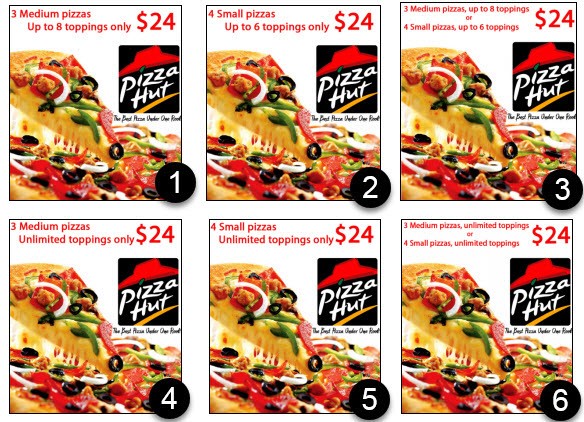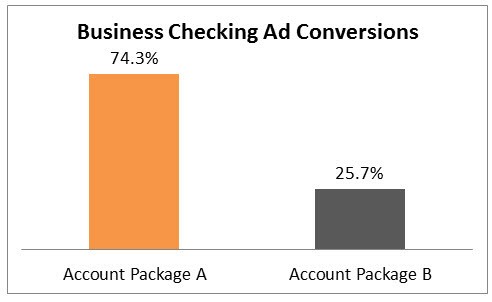How To Use the “Pricing Multiple Tactic” in Bank Product Marketing
Show a potential banking customer information, and their brain will quickly try to organize and synthesize the information. The easier the information is to organize, it turns out the more the viewer will like your ad. Our own Dr. Chris Janiszewski from the University of Florida and Dr. Dan King of the University of Singapore developed a theory on the “Fluent Processing of Numbers” and came up with research that tested the position in 2011. The theory was that consumers subconsciously like it when numbers add up. If you see that you can get 1 soda and 1 slice of pizza to save 2 dollars, your mind feels “comfortable” with the numerical sequence as it fits the common “1 + 1 = 2” framework. We wanted to know if this applies to bank product marketing, so we tested a variety of ads to see if we can increase business checking account conversions.
Testing Pizza Marketing
Janiszewski and King tested a variety of ads, such as the ones below. Here, they tested if operand prime numbers can influence the appeal of an offer. In the study, the professors had 141 participants test the below ads for brand liking, ad liking, and purchase intention. What they found was fascinating.

It turns out that ads where the numbers add up to a multiple of price, such as those in ads one, two, and three, did 22% better than the other ads. The interesting part is that those ads that outperformed were worse economic deals, as a consumer would rather have the “unlimited toppings” found in ads four, five, and six.
The Psychology of Bank Product Marketing
According to psychologists, we are drilled at a young age to understand basic numeric equations. While you may not explicitly conduct the multiplication or addition in your head, your mind doesn’t have to expend any extra energy trying to make sense of the numbers. You see three times eight and know it equals twenty-four, so you don’t stop to think about it and instead spend your energy looking at the pretty pictures and the overall meaning of the ad.
When it comes to marketing, this works as long as the implied equation is simple. Use three numbers, non-whole numbers or anything more than simple addition or multiplication in the base of the equation, and the effect no longer holds. In fact, if it gets too complicated, the opposite effect happens, and your ad becomes less effective compared to an ad that did not have a bunch of numbers.
Testing Deposit Account Marketing
While this might work for pizza, we were curious if this numerical fluency effect worked for banking. We devised a series of almost identical ads such as those below and gathered 210 potential customers to see which ones converted most effectively.


True to form, the effect was most pronounced when the numbers made relevant sense, such as those in ads for Account Package A and D. However, the best performance was when those ads where the numbers resulted in a true multiplication equation were compared to ads with few details such as the one in Account Package B. Here, the ads with the numbers were almost three times more likely to convert – a significant difference.

Package D performed 6% better than Package C on a standalone basis, but when shown both ads, the lower-priced account package won out. Our point here is that this tactic only works on a standalone basis. If you have a series of offers shown, about half of potential customers will do the math and choose the lower price account no matter what the numerical structure of the ad.
Putting This Bank Product Marketing Tactic into Practice
Instead of constructing a generic ad for banking products, structure the offer so that there is numerical fluency to aid processing. In addition to the above ads, some other examples are:
- Primer Plus checking is $15 per month but for the next 3-days, get $5 off per month.
- Save $500 on commercial loan closing costs if you refer 2 businesses (and they will save $250 each).
- Open a checking account with direct deposit in the next 3 months, and we will give you a one-time cash payment for $300.
When it comes to bank marketing, numbers can either work for you or against you. Use the above techniques to render better conversions and boost your marketing return on investment.

